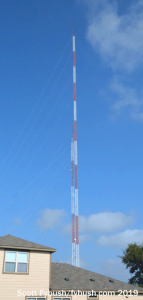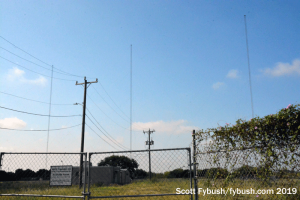NorthEast Radio Watch 12/15/2025: NYC Morning Shakeup
In this week’s issue… NYC morning shows exit - Carton back amidst WFAN shakeup - FM signing off in Canada - More radio centennials
Text and photos by SCOTT FYBUSH
San Antonio is a big place these days. The population has been on a steady increase, the suburban sprawl keeps on sprawling out, not only past the original I-410 beltway but now out to and beyond the Loop 1604 beltway – and there’s a big, bustling radio dial to see and hear, especially if you’ve never been here before.


Some scheduling quirks (combined with the lingering effects of our delayed flight into Dallas a day and a half earlier) meant we had barely 24 hours to see everything we wanted to see in San Antonio last September, and we’re already desperately eager to get back to see more.
So where to start our morning here? Having seen most of the city’s TV towers (and a chunk of the FM dial) the night before out on the southeast side of town near Elmendorf, we began the next day out on the northwest side, out near Helotes just outside Loop 1604. This is where the other big chunk of San Antonio FMs live, at a closely-spaced pair of towers off Galm Road.
The tall tower here is 1128 feet, with several big antennas at or near the top. The 8-bay ERI at the very top is a combined master antenna, carrying iHeart’s KAJA (97.3), Univision’s KBBT (98.5 Schertz), Cox’s KCYY (100.3) and KONO-FM (101.1 Helotes). A 4-bay ERI below that is an aux for KBBT and KCYY. There’s a 10-bay Dielectric below that, home to Texas Public Radio’s KPAC (88.3) and KSTX (89.1), and a four-bay ERI carrying Trinity University’s KRTU (91.7).
(Bit of trivia: KAJA was the very first station owned by Clear Channel Communications, back when it was just a new sideline business venture for a local used car dealer here, Lowry Mays, in the 1970s; back then, I’m pretty sure it was transmitting from the Transit Tower building, once the tallest skyscraper in downtown San Antonio.)
Want more history? Both 97.3 – then KITE-FM and KEEZ – and 100.3, then KBER-FM, transmitted (or at least had CPs) at various times in the 1960s from a self-supporting tower that still stands on Cesar Chavez Blvd. near the Riverwalk downtown; that tower was built for KCOR-TV 41, the first Spanish-language TV station in the city. 98.5 and 101.1 are both later move-ins to the market, 101.1 from Fredericksburg up north in the Hill Country, 98.3 from Pleasanton, to the south down I-37.



Making our way back to Loop 1604, we pass a newer AM site on the south side of Braun Road just west of the outer beltway: KRDY (1160) still bears the callsign from its days as a Radio Disney outlet, though it’s since passed through Salem’s hands and then to Relevant Radio, which runs its national Catholic programming through these three towers, with 10 kW day, 1 kW nights.
This station used to be on 1150, and it used to be KIKK (we’ll see those calls again in Houston in a few days) and then KBER, sister AM station to 100.3; at one time, 1150 and 100.3 shared a studio/transmitter site along what’s now I-410 on the southeast side of town, which survives now only as a dead-end street called “K-Ber Square.”
Let’s keep moving around the north side of the I-410 loop, shall we? Our next stop is just north of 410 in Leon Valley, at an important historic site in Spanish-language radio. Before there was a KCOR-TV, there was a KCOR radio, founded just after World War II by Raul Cortez – and after a few years as a non-directional daytimer at a different site closer to the center of town, by 1948 KCOR was here with a directional array, running 5 kW non-directional by day, 1 kW directional at night on 1350.


The array was rebuilt in 1961 to bring night power to 5000 watts as well. And there are still FM bays out here, from back in 1966 when KCOR-FM launched on 101.9. In 1971, KCOR changed calls to KQXT, moving to the new Tower of the Americas downtown, just a few blocks from the old KCOR studios. It was later owned by Group W, and it’s now part of the iHeart empire here, though it still has this site licensed as an aux.
KCOR AM and TV eventually became part of Univision; KCOR-TV is now KWEX, one of the most successful Univision affiliates in the country, and what was KCOR(AM) is now KXTN(AM), carrying on the Tejano format that was pioneered on its sister FM station at 107.5, now KVBH.


If we’d had more time, we’d have seen a few more AMs around town. Far out to the west is an old-line AM that beams a directional signal eastward into San Antonio: Cox’s KKYX (680) was KABC, KENS, KGBS and KBAT once upon a time, and its eastward beam carries all the way to Houston most of the time, with classic country. (The current KKYX site way out west dates only to the 1990s; the historic three-tower 680 site on Bandera Road, just west of the KCOR/KXTN site, has been paved over for a Walmart parking lot.)
Sister station KONO (860), playing classic oldies, has a two-tower array on the east side of town, tucked just inside where I-35 exits its merger with the I-410 loop, another newer replacement for an older site nearby. (We’ll explore more of KONO’s history when we head toward downtown in an upcoming installment.) Also along 410, where it rounds the northeast corner of its loop and 35 heads up toward Austin, is the two-tower array of KLUP (930 Terrell Hills), the station that once bore the calls KISS and now carries Salem’s “Answer” talk format.
We hope to get to all of those, and a few more, on a future trip. But we had to see two more AMs before time ran out, including a different AM site on the northeast side of town, just inside the 410 loop.


There aren’t many places in America where you can drive right through an AM directional array on a public road. We’ve chronicled many of them for you here over the years, including a few that are gone now – KWAL in Wallace, Idaho, with I-90 going right through it; WAYY 790 in Eau Claire, Wisconsin; and some survivors, such as KFMB 760 (now KGB) in San Diego and WDAE 620 in Tampa.


But we always knew there was another prominent one here in San Diego to see, and we finally got to drive through it on Eisenhauer Road, where the day tower and studios of KTSA (550) are located on the south side. At night, KTSA is a four-tower directional array, with two towers south of Eisenhauer and two more on the north side of the road.
There’s a fifth tower here, too, added less than a decade ago on the north side when the former KZEP (1250, now KZDC) began diplexing up here at night. The 1250 day site, with 25 kW into four towers, is far to the south of San Antonio along US 281; at night, it’s 920 watts into the three towers north of Eisenhauer and one of the towers to the south.
(1250 had a colorful history before it landed here, having lost its previous full-time site to development, only to then have its initial proposal for a new night site on the north side of town disrupted by construction of a quarry at the proposed new site, which is how it ended up here.)
In addition to news-talk KTSA and ESPN outlet KZDC, Alpha’s cluster at its studio here also includes top-40 KTFM 94.1, “Jack” KJXK 102.7 on the historic KTFM frequency, regional Mexican KSAH 720/KSAH-FM 104.1, and regional Mexican “La Ley” KLEY-FM 95.7/KHHL 103.1.
We packed a lot more San Antonio into this fast-paced day – join us again next week as we visit the newest studio complex in town!

As we announced a few weeks ago, the 2026 edition of the Tower Site Calendar will be the last.
We began publishing it 25 years ago, and the broadcast landscape is radically different now.
Radio World just ran an excellent article about us if you want to know more.
Once it’s gone, that’s it. We won’t be printing any more.
Thank you to everyone who saw our announcement and rushed to buy it. We appreciate you.
(There are some calendars from previous years if you want more of a tower photo fix — all under $5.)
But don’t wait to get this year’s Tower Site Calendar — buy it now!
We are selling the Broadcast Historian’s Calendar again this year, but we have that in an even smaller quantity — definitely don’t hesitate for that.
And visit the Fybush Media Store to check out our selection of books and videos, too!
And don’t miss a big batch of San Antonio IDs next Wednesday, over at our sister site, TopHour.com!
Next week: San Antonio – iHeart’s New Studios
In this week’s issue… NYC morning shows exit - Carton back amidst WFAN shakeup - FM signing off in Canada - More radio centennials
In this week’s issue… Veteran newsman returns - Remembering NY's Leitner, RI's Jones - CT AM saved - Maine AM moves - "Indie" adds suburban signals
In this week’s issue… Scripps stations face takeover - Sinclair moves more affiliations - CT stations sold - Maine AM surrendered - Remembering WVBR's Shapiro, WABC's Morgan
In this week’s issue… CT TV legend succumbs to cancer - Remembering PA's Adams - FCC still stalled by shutdown - Pittsburgh morning host exits